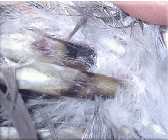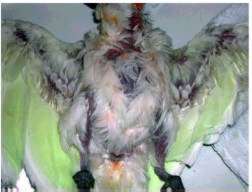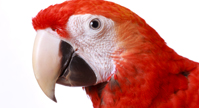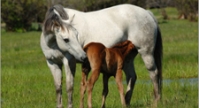Psittacine Beak and Feather Disease (PBFD)
Animal Genetics Inc. offers genetic testing for both type 1 and type 2 Psittacine Circovirus. Animal Genetics also offers Elisa testing to help determine if the bird has developed an immune response to the virus that causes PBFD.
Description:
 The virus causing Psittacine Beak and Feather Disease (PBFD) is a member of the Circoviridae family of viruses. The molecular structure of the genome of the virus is a roughly 2,000 base circular, single-stranded DNA. PBFD virus has a strong resemblance to Porcine Circovirus as well as to a number of plant viruses such as the Banana Bungy virus.
The virus causing Psittacine Beak and Feather Disease (PBFD) is a member of the Circoviridae family of viruses. The molecular structure of the genome of the virus is a roughly 2,000 base circular, single-stranded DNA. PBFD virus has a strong resemblance to Porcine Circovirus as well as to a number of plant viruses such as the Banana Bungy virus.
The disease is thought to be specific for psittacines and all psittacine species should be considered susceptible. Parrots known to be particularly affected by PBFD include, but are not limited to, Cockatoos, Macaws, African Grey Parrots, Ringneck Parakeets, Eclectus Parrots, and Lovebirds.
PBFD can cause fatal infections, primarily in young birds. Older birds may overcome the disease with few lasting affects. Some believe that these surviving birds become carriers that are able to shed the disease at a later date. Others believe that a percentage of birds are able to eradicate the disease from their system, leaving them with a natural immunity that can be passed on to their offspring.
The virus that causes PBFD can also affect the liver, brain, and immune system causing diminished resistance to infections. Consequently, premature death usually occurs from secondary bacterial, fungal, parasitic, or viral infections.
Transmission:
Transmission of the virus from one individual to another is primarily through direct contact, inhalation, or ingestion of aerosols, crop-feeding, infected fecal material, and/or feather dust. The virus can also be transmitted via contaminated surfaces such as bird carriers, feeding formula, utensils, food dishes, clothing, and nesting materials. If not destroyed, the viral particles can remain viable in the environment for months, long after the infected bird is gone.
Video of PBFD - Psittacine Beak and Feather Disease
Symptoms:

Symptoms include irreversible loss of feathers, shedding of developing feathers, development of abnormal feathers, new pinched feathers, and loss of powder down. Other possible symptoms include overgrown or abnormal beak, as well as symmetrical lesions on the beak and occasionally nails. Immunosuppression, rapid weight loss, and depression are also possible in later stages of the disease.
Secondary viral, fungal, bacterial, or parasitic infections often occur as a result of diminished immunity caused by a PBFD viral infection. Additional symptoms not mentioned above, including elevated white blood cell counts are generally due to secondary infections and may not be directly related to PBFD virus infections.
Diagnosis:
PBFD diagnosis is made by skin biopsy, surgical biopsy of feather and shaft, or PCR testing of blood, swab, and feather samples. Testing for PBFD-specific antibodies can also reveal important information about a possible infection.

PBFD should be considered in any bird suffering from abnormal feather loss or development. A biopsy of the abnormal feathers including the calimus (shaft) of the feather can be examined for signs of virus. However, since the PBFD virus does not affect all feathers simultaneously this method of evaluating a sample may have a high degree of error. Additionally, birds with PBFD can have normal feathers, so PCR testing is the most effective method available for detecting the virus in birds before feather lesions develop.
Some birds infected with the virus test positive but never show clinical signs. Other birds which test positive may develop an immune response sufficient enough to fight off the infection and test negative after 30-90 days. Therefore, it is recommended to re-test all PBFD positive birds 60-90 days after the initial testing was completed. If the second sample remains positive, the bird should be considered permanently infected and can be expected to show clinical symptoms of the disease.
Sample Type:
To test an individual bird, a blood card or blood vial can be submitted. A feather sample can be submitted if abnormal or suspicious-looking feathers are observed. If the sample tests positive, the bird should be placed in quarantine and re-tested after 4-6 weeks. If the bird tests negative the second time, a third test after 4-6 weeks is recommended. ELISA testing will confirm the presence of PBFD-specific antibodies and can help indicate if the bird will develop PBFD or not.
Post-mortem samples include liver, spleen, kidney and/or feather samples in a sterile container. Post-mortem swabs may also be submitted.
Environmental testing using swabs of aviaries, counter tops, fans, air-filters, nest-boxes, etc. is extremely effective in determining the presence of PBFD DNA in the environment.
Accuracy of Our Disease Testing
In a blind study published in The Journal of Avian Medicine and Surgery conducted by Dr. Geoff Olsen and Dr. Brian Speer Animal Genetics/Avian Biotech was the only laboratory to get a perfect score on all positive and negative test results.
Please contact us for a copy of this study or follow the link below.
Reference: Journal of Avian Medicine and Surgery 23(3): 194-198, 2009
Limitations:
As with any genetic test, new mutations may occur in the viral genome that could affect the assay. Therefore, it may be difficult to detect all subtypes. Sample collection plays a pivotal part in the overall accuracy of the test so please use caution and follow the instructions carefully.
Submit a Sample for Testing:
To submit a sample, download a test submission form at Downloads
Cost per sample is $24.50. Please see our fee schedules below for bulk and combination rates.










